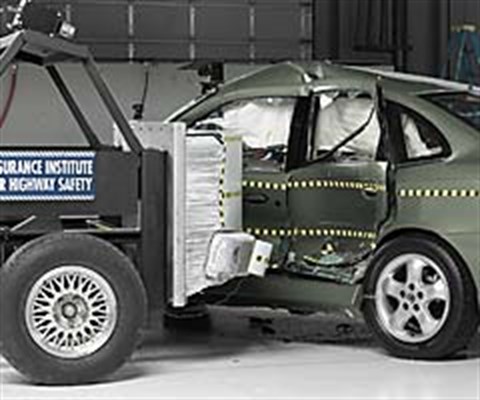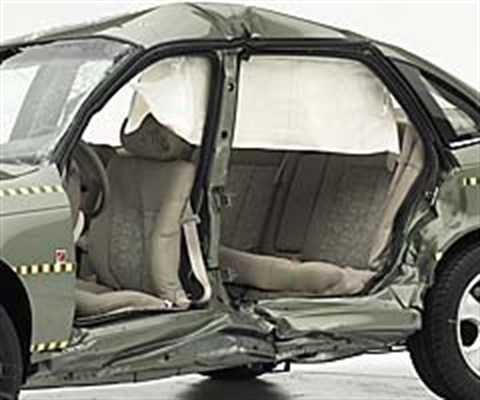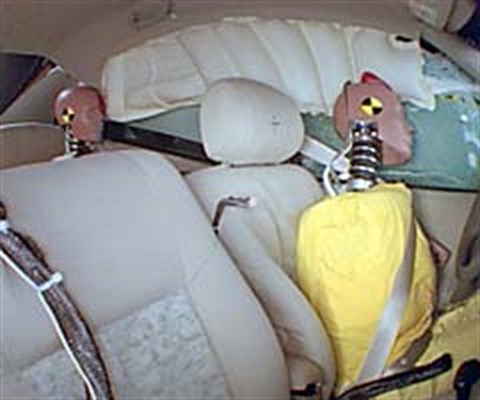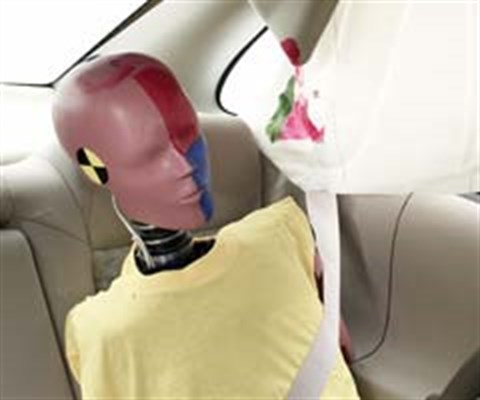Moderate overlap front: original test
Rating applies to 2000-05 models
Tested vehicle: 2000 Saturn LS2 4-door
The Saturn L Series was introduced in the 2000 model year and discontinued after a limited number of 2005 models were manufactured.
| Evaluation criteria | Rating |
|---|---|
| Overall evaluation | |
| Structure and safety cage | |
| Driver injury measures | |
| Head/neck | |
| Chest | |
| Leg/foot, left | |
| Leg/foot, right | |
| Driver restraints and dummy kinematics Dummy movement was reasonably well controlled. During rebound from the airbag, the dummy moved toward the driver door, and its head went partway through the open window. Then the head moved back in and hit the B-pillar and top of the door opening. |
|

Action shot taken during the frontal offset crash test.

The dummy's position in relation to the steering wheel and instrument panel after the crash test indicates that the driver's survival space was maintained reasonably well.

Moderate footwell intrusion contributed to the likelihood of right leg injury.

Damage was minimal in a 5 mph rear-into-pole impact.
Measures of occupant compartment intrusion on driver side
| Evaluation criteria | Measurement |
|---|---|
| Test ID | CF99022 |
| Footwell intrusion | |
| Footrest (cm) | 17 |
| Left (cm) | 20 |
| Center (cm) | 18 |
| Right (cm) | 19 |
| Brake pedal (cm) | 14 |
| Instrument panel rearward movement | |
| Left (cm) | 5 |
| Right (cm) | 4 |
| Steering column movement | |
| Upward (cm) | 7 |
| Rearward (cm) | 0 |
| A-pillar rearward movement (cm) | 3 |
Driver injury measures
| Evaluation criteria | Measurement |
|---|---|
| Test ID | CF99022 |
| Head | |
| HIC-15 | 236 |
| Peak gs at hard contact | negligible |
| Neck | |
| Tension (kN) | 1.8 |
| Extension bending moment (Nm) | 17 |
| Maximum Nij | 0.32 |
| Chest maximum compression (mm) | 28 |
| Legs | |
| Femur force - left (kN) | 4.5 |
| Femur force - right (kN) | 1.5 |
| Knee displacement - left (mm) | 2 |
| Knee displacement - right (mm) | 6 |
| Maximum tibia index - left | 0.68 |
| Maximum tibia index - right | 1.42 |
| Tibia axial force - left (kN) | 1.1 |
| Tibia axial force - right (kN) | 5.7 |
| Foot acceleration (g) | |
| Left | 101 |
| Right | 138 |
Side: original test
Rating applies to 2002-05 models
Tested vehicle: 2004 Saturn L300.2 4-door with standard front and rear head curtain airbags
The Saturn L Series was introduced in the 2000 model year. Side curtain airbags for drivers' and front and rear outboard passengers' heads were made optional on 2001 models and standard beginning with 2002 models. The L Series was discontinued after a limited number of 2005 models were manufactured.
| Evaluation criteria | Rating |
|---|---|
| Overall evaluation | |
| Structure and safety cage | |
| Driver injury measures | |
| Head/neck | |
| Torso | |
| Pelvis/leg | |
| Driver head protection The dummy's head brushed past the side curtain airbag and was hit by the intruding barrier. This impact did not produce high head injury measures, but head hits with intruding objects such as other vehicles, trees, and poles should be prevented. |
|
| Rear passenger injury measures | |
| Head/neck | |
| Torso | |
| Pelvis/leg | |
| Rear passenger head protection | |

View of the vehicle and barrier just after the crash test.

View of the vehicle after the crash with doors removed, showing the side airbag and damage to the occupant compartment.

Action shot taken during the side impact crash test showing the driver dummy's head brushing past the side airbag and about to be hit by the intruding barrier.

Smeared greasepaint shows where the rear passenger dummy's head was protected by the side airbag.
Measures of occupant compartment intrusion on driver side
| Test ID | CES0314 |
|---|---|
| B-pillar to longitudinal centerline of driver's seat (cm) | 2.5 |
| Negative numbers indicate the amount by which the crush stopped short of the seat centerline. | |
Driver injury measures
| Evaluation criteria | Measurement |
|---|---|
| Test ID | CES0314 |
| Head HIC-15 | 284 |
| Neck | |
| Tension (kN) | 1.8 |
| Compression (kN) | 0.7 |
| Shoulder | |
| Lateral deflection (mm) | 61 |
| Lateral force (kN) | 3.7 |
| Torso | |
| Maximum deflection (mm) | 44 |
| Average deflection (mm) | 35 |
| Maximum deflection rate (m/s) | 8.44 |
| Maximum viscous criterion (m/s) | 1.58 |
| Pelvis | |
| Iliac force (kN) | 3.8 |
| Acetabulum force (kN) | 3.6 |
| Combined force (kN) | 7.3 |
| Left femur | |
| L-M force (kN) | 0.8 |
| L-M moment (Nm) | 79 |
| A-P moment (Nm) | 44 |
Passenger injury measures
| Evaluation criteria | Measurement |
|---|---|
| Test ID | CES0314 |
| Head HIC-15 | 386 |
| Neck | |
| Tension (kN) | 0.6 |
| Compression (kN) | 0.4 |
| Shoulder | |
| Lateral deflection (mm) | 46 |
| Lateral force (kN) | 1.7 |
| Torso | |
| Maximum deflection (mm) | 32 |
| Average deflection (mm) | 30 |
| Maximum deflection rate (m/s) | 4.07 |
| Maximum viscous criterion (m/s) | 0.45 |
| Pelvis | |
| Iliac force (kN) | 0.7 |
| Acetabulum force (kN) | 2.1 |
| Combined force (kN) | 2.6 |
| Left femur | |
| L-M force (kN) | 0.9 |
| L-M moment (Nm) | 250 |
| A-P moment (Nm) | 17 |
Head restraints & seats
Seat type: All seats
| Overall evaluation | |
|---|---|
| Dynamic rating | |
| Seat/head restraint geometry |
| Seat type | All seats |
|---|---|
| Geometry | |
| Backset (mm) | 80 |
| Distance below top of head (mm) | 125 |
| Seat design parameters | |
| Pass/fail | Fail |
| Max T1 acceleration (g) | 0.0 |
| Head contact time (ms) | |
| Force rating | 0 |
| Neck forces | |
| Max neck shear force (N) | |
| Max neck tension (N) | |
About the head restraint & seat test
Currently, IIHS tests apply only to front seats.
